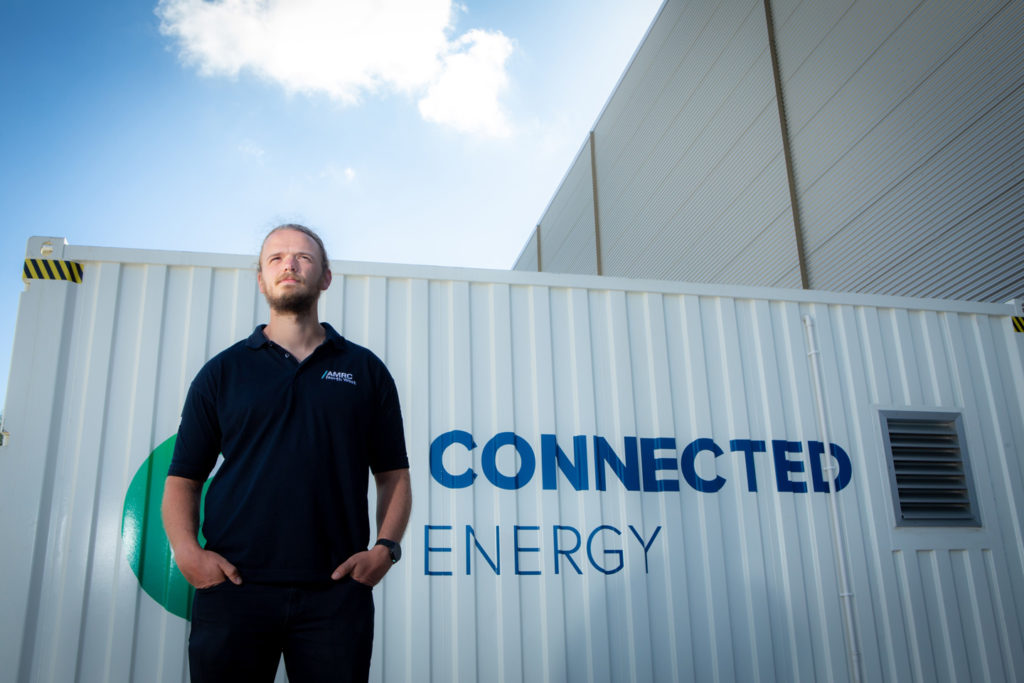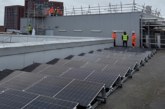A key component of the UK’s most advanced building energy management system, a second life battery energy storage system, launches successfully at AMRC North West.
As the manufacturing industry struggles with rising energy costs and pressure to decarbonise, an energy solution, which couldn’t come at a better time for businesses, has been successfully installed at AMRC North West in Lancashire.
Two battery energy storage systems (BESS) supplied by Connected Energy have been successfully integrated on the site to link to a range of renewable technologies.
This marks an important stage for the UK’s manufacturing sector as the AMRC site is the most advanced low carbon smart building demonstrator created specifically for this strategically important sector. The installation is designed to show how energy costs and carbon emissions can be controlled by manufacturers of all sizes, and in buildings of any age.
The BESS will be linked to two types of photovoltaic panels, one standard rooftop array and another comprising two smart flowers which open and track the sun through the day. It will enable the site, part of the University of Sheffield Advanced Manufacturing Research Centre’s (AMRC) network of research and innovation centres, to store and use its own clean energy, keeping the centre on its green tariff at all times and serving as the data ‘heart’ of a new fully digitised building and manufacturing site.
With operational machinery and production lines using the Industrial Internet of Things (IIoT) the site will be a manufacturing energy ‘show home’. It will allow manufacturers see how they can achieve what, at present, might seem impossible — manage and reduce energy bills, reduce carbon emissions and yet increase energy consumption and security.
The £2.5m project at AMRC North West, supported by the Lancashire Enterprise Partnership (LEP) through the Government’s Getting Building Fund (GBF), will create a road map for manufacturers that will enable them to cut the carbon footprint of older facilities and achieve net zero by 2050.
Ben Smith, Low Carbon Smart Building Specialist at AMRC North West said: “Any business with renewables on site could hugely benefit from a battery storage solution. For us, it will allow us to maximise the energy generated from our renewables. For others like those in construction and manufacturing, two of the heaviest carbon polluters per person and the hardest to change, it will show what steps can be made with a BESS on the ground.”

This summer’s heatwave across Europe has focussed minds again on the need to address climate change, and the war in Ukraine has highlighted the need for energy security. However, for businesses struggling with fuel bills, the idea of switching to smart solutions can feel like an impossible goal.
This is why the practical benefits and strategic significance to manufacturers of the systems on display at the Lancashire demonstrator site cannot be overstated. Businesses have seen energy costs increase dramatically and bills of over £1m per annum are now not uncommon. Energy bill reduction is just one benefit of new energy technology that the AMRC site will demonstrate.
Electricity consumption in the UK is predicted to increase by 50% by 2035[1], yet many businesses in the country already face grid constraints. The battery storage units at AMRC North West mean it will never have to increase its electricity capacity, even when more equipment is installed, and always be able to operate within its green tariff by storing energy from the renewables on site.
The choice of BESS from Connected Energy was particularly important with respect to environmental credentials, being made from second life vehicle batteries, each system using 24 Renault Kangoo 15kWh batteries.
Matthew Lumsden, CEO, Connected Energy, said: “We are very proud to be chosen by the University of Sheffield AMRC for this project which will become the hallmark of energy best practice for the manufacturing sector. Being a demonstrator site is especially important to us as it allows us to showcase some of the major benefits of introducing battery storage into a commercial setting.”
The entire system will showcase how an intelligent approach to energy can reduce costs and carbon emissions in manufacturing. For example, by using AI and data modelling, the BESS can be automatically programmed to provide energy to the site at peak production times, using excess renewables or at times when tariffs are higher. By installing a BESS, manufacturers will be able to automatically switch between the system and the national grid to minimise costs and maximise revenue through arbitrage.
The AMRC site will take this one step further, to automatically coordinate meteorological data with BESS data so that it is prepared in advance to maximise revenue opportunities around weather conditions.
Melissa Conlon, Commercial Director, University of Sheffield AMRC North West, said: “The cost of energy, financially and environmentally, is of global importance and integral to manufacturers of every size and type. I am delighted that we are able to showcase this system at AMRC North West which will help regional manufacturer in this area take a step forward in the race to reach net zero targets. There are more than 3,000 manufacturing small and medium-sized enterprises (SMEs) in the North West so we have a real opportunity to make a significant difference to the region’s supply chain.”
In July, a group of executives from local councils, local government and the private sector, including Oxfordshire, Westminster, Nottingham, Milton Keynes and TfL visited the Cranfield University campus where Connected Energy has installed three second life battery storage systems, to see how BESS integrates with other technologies and understand what aspects would work for them. You can read that article here.









